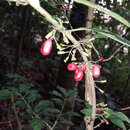Comprehensive Description
(
anglais
)
fourni par North American Flora
Deppea excelsa (H.B.K.) Standley
Psychotria excelsa H.B.K. Nov. Gen. & Sp. 3: 355. 1819. Choristes excelsa Benth.; Walp. Rep. 2: 506. 1843. Deppea tenuiflora Benth. PI. Hartw. 349. 1857.
Shrub, the branches slender, grayish, bifariously puberulent when young, the internodes elongate; stipules minute, deltoid; petioles slender, 3-10 mm. long, puberulent; leaf -blades ovate, elliptic-oblong, or lance-oblong, 3-7.5 cm. long, 1.5-3 cm. wide, acute to attenuate at the base, subabruptly acuminate or attenuate at the apex, very thin, bright-green above, sparsely pilose when young, the venation plane or prominulous, paler beneath, puberulent or sparsely pilose along the veins, glabrate in age, the lateral veins slender, arcuate; inflorescence axillary, umbellate, 3-10-flowered, the peduncles 3-10 mm. long, the pedicels slender, 2-5 mm. long; hypanthium glabrous; calyx-lobes minute, deltoid, acutish; corolla glabrous, the tube cylindric, the lobes oblong, obtuse, slightly longer than the tube; capsule turbinate, 3-4 mm. long, conspicuously costate ; seeds minute, dark reddish-brown.
Type locality: Near Jalapa, Veracruz, altitude about 1345 meters. Distribution: Veracruz and Chiapas.
- citation bibliographique
- Paul Carpenter Standley. 1921. RUBIALES; RUBIACEAE (pars). North American flora. vol 32(2). New York Botanical Garden, New York, NY
Comprehensive Description
(
anglais
)
fourni par North American Flora
Hoffmannia uniflora Standley, Contr. U. S. Nat. Herb. 20: 204
1919.
Branches fruticose, slender, brownish, the branehlets very slender, subterete, bifariously rufous-puberulent, the internodes short; stipules deltoid, acutish, 1 mm. long, deciduous; leaves opposite, the petioles slender, 3-6 mm. long, sparsely puberulent, the blades narrowly oblong-elliptic or lance-elliptic, 4—8 cm. long, 1-2 cm. wide, attenuate to the base, acuminate or long-acuminate at the apex, membranaceous, deep-green above, glabrous, paler beneath, sparsely puberulent along the veins or glabrate, the lateral nerves very slender, about 6 on each side, arcuate-divaricate or ascending; flowers mostly solitary, sometimes in 2-flowered cymes, the pedicels slender, 3-6 mm. long, glabrate; calyx-lobes linear, acute, in fruit 2-3 mm. long; fruit oval, 6-7 mm. long, 5-6 mm. wide, costate, glabrous; seeds minute, brownish, coarsely reticulate.
Type locality: Near Cohan, Alta Verapaz, Guatemala, altitude 1100 meters. Distribution: Known only from the type locality.
- citation bibliographique
- Paul Carpenter Standley. 1934. RUBIALES; RUBIACEAE (pars). North American flora. vol 32(3). New York Botanical Garden, New York, NY
Comprehensive Description
(
anglais
)
fourni par North American Flora
Hoffmannia excelsa (H. B. K.) K. Schumann, in Mart. Fl. Bras
6 6 : 327. 1889.
Psychotria excelsa H.B.K. Nov. Gen. & Sp. 3: 355. 1819. Coffea lanceolata Schlecht. & Cham. Linnaea 6: 412. 1831. Ilixxinsia mexicana Link, Klotzsch. & Otto, Ic. PI. Rar. 57. 1841. Choristes excelsa Benth.; Walp. Rep. 2: 506. 1843. Hoffmannia mexicana Hemsl. Biol. Centr. Am. Bot. 2: 37. 1881. Deppea excelsa Standley, N. Am. Flora 32: 89. 1921*
A slender, often densely branched shrub 60-120 cm. high, the branches grayish or green, densely ferruginous-puberulent when young, the internodes short or elongate; stipules minute, deltoid, deciduous; leaves small, opposite, the slender petioles 3-13 mm. long, puberulent; leaf-blades obovate, elliptic, or elliptic-oblong, 2-9.5 cm. long, 0.7-3 cm. wide, acute to acuminate, rarely obtuse, acute to attenuate at the base or rarely obtuse or rounded, membranaceous, bright-green and glabrous above, paler beneath, puberulent or villosulous on the veins, the lateral nerves slender, 4-6 on each side, arcuate-divaricate; cymes sessile or short-pedunculate, mostly 2-flowered, the slender pedicels 3 mm. long or shorter; calyx and hypanthium 2 2.5 mm. long, glabrous or nearly so, the calyx-lobes minute, deltoid; corolla yellow, 7 mm. long, sparsely puberulent or villous outside, the lobes oblong, obtuse or acutish, spreading, about twice as long as the tube; anthers subsessile, exserted; berries 2-celled, red, globose or oblong, 5-9 mm. long; seeds minute, brown, foveolate.
Type locality: Near Jalapa. Veracruz, altitude about 1345 meters.
Distribution!: Wet mountain forest. Veracruz, Oaxaca, and Chiapas.
- citation bibliographique
- Paul Carpenter Standley. 1934. RUBIALES; RUBIACEAE (pars). North American flora. vol 32(3). New York Botanical Garden, New York, NY
Hoffmannia excelsa
(
vietnamien
)
fourni par wikipedia VI
Hoffmannia excelsa là một loài thực vật có hoa trong họ Thiến thảo. Loài này được (Kunth) K.Schum. mô tả khoa học đầu tiên năm 1889.[1]
Chú thích
Liên kết ngoài
- licence
- cc-by-sa-3.0
- droit d’auteur
- Wikipedia tác giả và biên tập viên
Hoffmannia excelsa: Brief Summary
(
vietnamien
)
fourni par wikipedia VI
Hoffmannia excelsa là một loài thực vật có hoa trong họ Thiến thảo. Loài này được (Kunth) K.Schum. mô tả khoa học đầu tiên năm 1889.
- licence
- cc-by-sa-3.0
- droit d’auteur
- Wikipedia tác giả và biên tập viên

